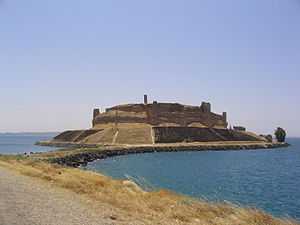Suleyman Shah
| Suleyman Shah سلیمان شاه | |||||
|---|---|---|---|---|---|
| Leader of the Kayı tribe (pre-Ottoman Empire) | |||||
| Reign | ?–1230 | ||||
| Predecessor | Kaya Alp | ||||
| Successor | Ertuğrul | ||||
| |||||
| Father | Kaya Alp | ||||
| Born | Unknown | ||||
| Died |
1236 Euphrates | ||||
| Religion | Islam | ||||

Suleyman Shah (سلیمان شاه, full name: سلیمان بن کیا آلپ Süleyman bin Kaya Alp; c. 1178 – 1236)[1] was the son of Kaya Alp and the father of Ertuğrul, who was, in turn, the father of Osman I, the founder of the Ottoman Empire. His other son was Saru Yatı, the father of Bay Hodja. It is said that Suleyman Shah drowned in the river Euphrates in Syria. An Ottoman tomb in or near Qal'at Ja'bar has historically been associated with Suleyman Shah.[2] In accordance with Article 9 of the Treaty of Ankara (1921) signed between France and Turkey, an area (8,000 square meters or one hectare) containing the tomb remained Turkish property (but not sovereign territory). [3]
When the area where the tomb was located in 1921 was later flooded in 1974 by Lake Assad, the reservoir of the Tabqa Dam, the tomb and artifacts were moved to a new location 85 km north of Qal'at Ja'bar to 36°38′22″N 38°12′27″E / 36.63944°N 38.20750°E,[4] but also on the Euphrates riverside, 10 kilometres (6.2 mi) northwest of the town of Sarrin and located 27 km from the Turkish frontier. Throughout the Syrian Civil War, Turkey maintained a small military presence as an honour guard around the tomb.[5]
On the night of 21–22 February 2015, a Turkish military convoy including tanks and other armored vehicles numbering about 100 entered Syria to evacuate the tomb's 40 guards and relocate the remains.[6] One soldier died during the operation.[6] The tomb complex was destroyed to prevent its use by ISIS.[6][7]
The tomb is now located in Turkish-controlled territory 200 meters inside Syria, 22 km (14 mi) west of Kobanî and 5 km (3.1 mi) east of the Euphrates, less than 2 km (1.2 mi) southeast of the Turkish village of Esmesi (Esmeler or Esme or Eshme) that is in southernmost Birecik District. [8]
Prime Minister Ahmet Davutoglu said that later a new tomb will be constructed in Syrian territory.[9]
See also
References
- ↑
- ↑ Sourdel, D. (2009). "ḎJ̲abar or Ḳalat ḎJ̲abar". In P. Bearman, Th. Bianquis, C.E. Bosworth et al. Encyclopaedia of Islam (2nd ed.). Brill online.
- ↑ "Franco-Turkish agreement of Ankara" (in French). Retrieved 19 September 2009.
- ↑ Burns, R. (1999). Monuments of Syria. An historical guide. London: I.B. Tauris. pp. 180–181. ISBN 1-86064-244-6.
- ↑ "Are Turkish troops guardians or accidental hostages at Syrian tomb?". al-Monitor. February 5, 2015.
- ↑ 6.0 6.1 6.2 Daniel Dombey, Erika Solomon, 'Turkish troops enter Syria to remove 13th century Suleyman Shah tomb', Financial Times, 23 February 2015, p. 9
- ↑ "Turkey enters Syria to evacuate Suleyman Shah tomb". BBC. 22 February 2015. Retrieved 22 February 2015.
- ↑ "Turkish military enters Syria to evacuate soldiers, relocate tomb". Reuters. Retrieved 22 February 2015.
- ↑ "Turkey sends military into Syria, evacuate troops and tomb". YnetNews. 22 February 2015. Retrieved 22 February 2015.
| Preceded by Kaya Alp |
Pre-Ottoman ruler ? – 1230 |
Succeeded by Ertuğrul |